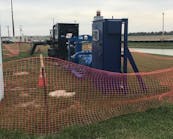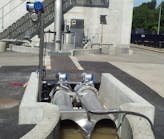| Related Searches from WaterInfoLink.com Manhole Lining | Lowries Run Interceptor Project | Three Rivers Wet Weather Demonstration Program | Sauereisen |
For municipalities struggling to deal with sewage overflow issues, simply getting started can be a major challenge. Fortunately, the Lowries Run Interceptor Project serves as an excellent case study illustrating multi-jurisdictional collaboration.
Protecting Public Health and Finances
In the late 1990s, a handful of municipalities chose to confront the environmental concerns of water inflow and infiltration within their sanitary sewers. A series of 84 manholes exhibited various levels of deterioration along the Lowries Run Creek. Most of the manholes were approximately 40 to 50 years old and had suffered from the effects of freeze-thaw cycles over the years. Resulting damage consisted of open mortar joints within brick manholes and excessive spalling within concrete structures.
With the infrastructure in this condition, Western Pennsylvania’s rainy climate and rolling topography combined to make the Lowries Run manholes a source of entry for excessive groundwater. It became increasingly apparent that something needed to be done because the 10-mile-long sewer line fed into the Allegheny County Sanitary Authority (ALCOSAN) treatment plant along the Ohio River.
Aside from public health issues, restoration (rather than replacement) of the Lowries Run collection system made fiscal sense. Therefore, it was a priority to avoid such an expense by restoring the existing system sooner rather than later.
Aligning with Public and Private Partners
The Lowries Run stakeholders realized the importance of seeking commitment in both the public works and public health arenas. Fortunately, such a unified body existed in Pittsburgh through the work of the Three Rivers Wet Weather (3RWW) Demonstration Program. Created in 1998, 3RWW is a unique partnership between ALCOSAN and the Allegheny County Health Department.
Selection and installation of restorative materials was another matter to address. The fold and form method of cured-in-place pipe (CIPP) was used for the smaller diameter sewer lines. Applied by a method known as sliplining, many of the problem areas could be repaired quickly and with little difficulty.
The company’s offerings included a broad array of materials to choose from, including both organic polymers and cementitious formulations. After a thorough review of the sewers and manholes it was determined to apply a cement-based restoration material, H2OPruf No. F-190 , upon Sauereisen’s recommendation.
With complete confidence in the physical properties of the substrate repair material, the assembled team and Sauereisen turned attention toward installation procedures. Standard installation of H2OPruf had always required hand application using a masonry brush, but speed was important and a more expedient application solution was needed.
In seeking ways to accelerate application, Sauereisen turned to its equipment vendors. Since the company’s protective linings are commonly sprayed, pumped or gunited, there were several options to consider. With brick manholes being prevalent along Lowries Run and particularly challenging to restore, the company sought some progressive approaches in an effort to offer the most cutting-edge solution.
Along with a robotic waterblaster used for surface preparation, the company incorporated a progressive spincasting methodology to apply the restoration materials within the manholes. This installation method featured a spinning spray nozzle fed by a pump from street level. In this manner, most of the work was accomplished without confined space entry, making for a faster, safer application. Workers from the McCandless Sanitary Authority claimed that their production rate increased from a single manhole completed per day to eight manholes restored in a single shift.
Since the project in 2001, follow-up inspections were conducted on an annual basis. In-depth rounds of inspections in 2006 found little change in the linings. More impressive was the condition of the manhole lining following the catastrophic rain event caused by the remnants of Hurricane Ivan. In spite of a large amount of debris being introduced into the sewers, the manhole lining remained intact and proved durable.

